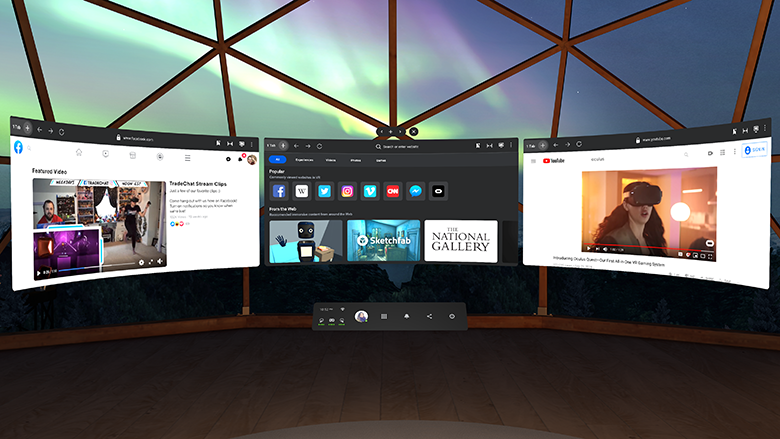
March 16, 2020 – Oculus has today unveiled a major update to the Oculus Quest system experience that the company states will make virtual reality on its standalone device more flexible, social, and easy to use. It comes with a completely redesigned universal menu, new immersive overlays, and multi-window support for 2D apps starting with Oculus Browser. The updates are to launch as Experimental Features on the Quest later this month.
Oculus stated: “The VR platform of the future must enable people to multitask easily, navigate between apps seamlessly, stay connected with others, and quite simply do more. From gaming to media and entertainment, from social experiences to getting work done, VR as the next computing platform will support the full spectrum of uses that people expect from their devices, like phones and laptops, today.” Today’s announcement marks Oculus taking another step toward that future.
The redesigned universal menu is a personal dashboard that lets users navigate between immersive environments and 2D apps, control their device, and stay connected with people and with the system’s status while in VR. The new design organizes information more clearly to help users navigate to commonly-used system apps like Explore, Store, Browser, and TV more quickly, as well as access key settings like brightness and volume. It also brings recently and frequently used apps front and center so it’s easier to jump back into the action.
New immersive overlays make it possible to bring up content, like the universal menu, without leaving the app that is in use. Oculus states that this means it will be easier to find and control system functions without the need to return to the Home screen. Furthermore, tools for sharing and connecting are easier to access while users explore VR, with the update bringing seamless access to functions like making a friend request, casting, or livestreaming (Facebook login required). This will be available in WebXR apps launched from Oculus Browser to start with, and will come to more apps on the Oculus Platform as developers add support. Over time users should have instant access to their menu anytime and anywhere in VR.
Additionally, Oculus Browser now supports multiple windows, helping users to better multitask by watching a video in one window, check out social media updates in another, and catch up on the day’s news in a third for example. Windows can be opened, closed, and rearranged from a new control box above the window. Support for multiple windows will first come to Oculus Browser, with support for more 2D apps like Chats and Store coming later.
Oculus states that these updates continue to evolve the Quest experience and represent a step toward VR becoming the next computing platform. Updates will start rolling out this month, and users will be able to opt in by going to the Experimental Features section in Settings and toggling the new features on.
Image credit: Oculus
About the author
Sam is the Founder and Managing Editor of Auganix. With a background in research and report writing, he has been covering XR industry news for the past seven years.




